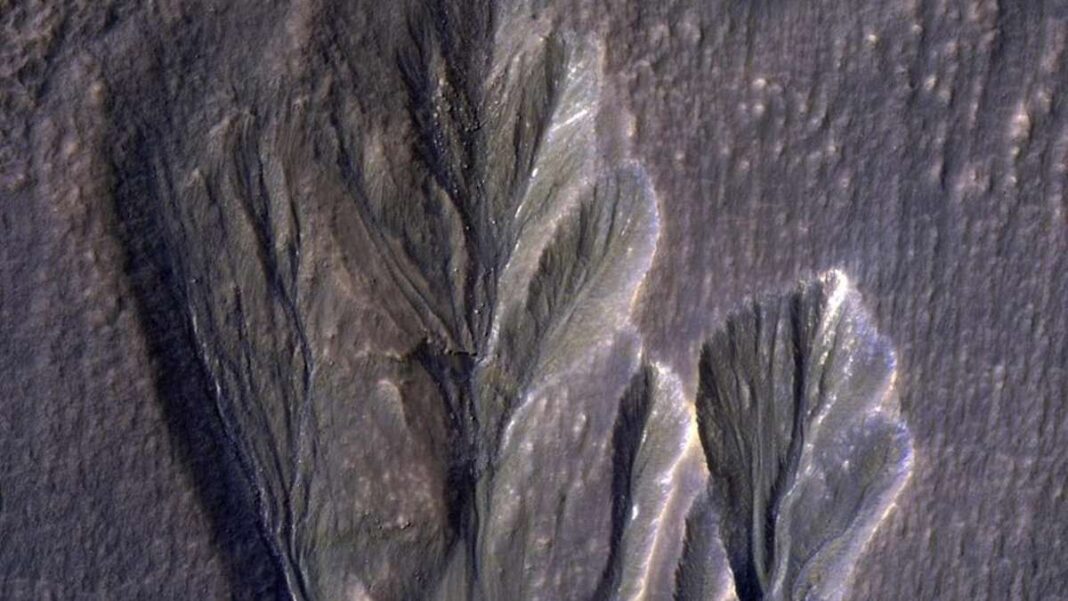Alien life could be lurking on Mars, NASA says,
A NASA-led study has revealed that alien life could be hiding beneath the icy layers of Mars.
Scientists suggested that the Red Planet’s ancient ice packs may have long acted as a shield for microbial life, blocking out deadly cosmic radiation.
But the key to their survival would be ice that likely formed from dusty snowfall, where sunlight absorbed by that darker dust would allow pockets of melt water to develop safely under its icy surface, lead author Dr Aditya Khuller told DailyMail.com.
Computer modeling showed that the amount of light piecing the water ice could trigger photosynthesis in these shallow pools of meltwater — similar to pools on Earth that are teeming with life.
‘These are called “cryoconite holes” and form when dust and sediment on top of the ice melt into the ice because it is darker than the ice,’ said Dr Khuller, who worked as a planetary scientist at NASA’s Jet Propulsion Laboratory.
A host of tiny, plant-like creatures have been documented in cryoconite holes on Earth — including algae, fungi, and cyanobacteria, all of which pull in energy from the sun via photosynthesis to live.
‘If we’re trying to find life anywhere in the universe today, Martian ice exposures are probably one of the most accessible places we should be looking,’ Dr Khuller said.
These cryoconite colonies have been uncovered and studied everywhere from Antarctica, to Greenland, to Norway’s Svalbard archipelago: an island chain midway between the Scandinavian country’s northern coast and the North Pole.
‘The microorganisms typically go dormant in the winter,’ Dr Khuller told Space.com, ‘when there is not enough sunlight to form liquid water within the dusty ice.’
‘So, the two key ingredients for photosynthesis can be present within dusty Martian ice in the mid-latitudes,’ he added. ‘Photosynthesis requires adequate amounts of sunlight and also liquid water to occur.’
The new study builds off of Dr Khuller’s work as a PhD student, when he worked on a project to predict the dust content of ice deposits on Mars — based off of data collected by NASA’s Phoenix Mars Lander and its Mars Reconnaissance Orbiter.
The team poured this data into computer simulations that were originally built to predict the brightness of terrestrial snow and glacier ice on Earth.
These brightness models built off of Earth’s well-studied and better understood ice, they theorized, would help estimate the dust content mixed into distant Martian ice.
‘This small amount of dust has a very important effect,’ Dr Khuller told DailyMail.com.
‘The depth to which enough sunlight can reach for photosynthesis to occur within the ice changes depending on how dusty the ice is,’ he noted. ‘Similarly, the amount of dust within the ice also changes the depth [down] to which harmful ultraviolet radiation can penetrate.’
The team’s computer modelling efforts predicted that ice containing higher amounts of dust, 0.01 to 0.1 percent, will only be able to support life at a depth around five to 38 centimeter below the surface.
But, Dr Khuller noted: ‘There are zones where photosynthesis could occur at […] meter-depths for cleaner ice.’
The cleaner ice was found to be especially fertile territory for deeper pockets of microbial life along Mars’ mid-latitude ranges, in both its northern and southern hemispheres.
At 40° latitude in both hemispheres, these colonies of tiny alien life could exist as far down as 2.15 to 3.10 meters deep, based on Dr Khuller and his team’s estimates, published Thursday in the journal Nature Communications Earth & Environment.
‘We are not stating we have found life on Mars,’ Dr Khuller emphasized to reporters, ‘but instead we believe that dusty Martian ice exposures in the mid-latitudes represent the most easily accessible places to search for Martian life today.’
But, complicating matters, Mars, unlike Earth, has two different kinds of naturally occurring ice: frozen water and frozen carbon dioxide, a la man-made ‘dry ice.’
Thanks to the thin and dry atmosphere on Mars, planetary and atmospheric scientists are still debating whether or not melting ‘water ice’ even becomes liquid water there at all — with many arguing it ‘sublimates’ immediately into water vapor.
Melting water ice shielded under layers of ice and snow might fare better, but there is still a lot of guess work in this process, Dr. Khuller noted.
‘As far as I know, it is currently believed that Martian dust across the planet has the same composition,’ he continued.
‘However, we currently do not have any samples of Martian material returned to Earth for detailed analyses,’ he added, ‘so it is difficult to be sure.’
‘We’d love to access samples from within that ice at some point, but that’s for a future mission to consider.’ told DailyMail.com
Big questions remain as to whether or not photosynthetic life exists on Mars now or even if it once did during its earlier epochs, when it had more liquid water and a stronger magnetosphere to protect it from the sun’s cosmic rays.
But, at least, for now, Dr Khuller and his colleagues have helped narrow down where alien life is most likely to be on the vast 55.74 million square-miles of Martian surface.
‘I am working with a team of scientists to develop improved simulations of if, where, and when dusty ice could be melting on Mars today,’ Dr Khuller told DailyMail.com.
‘Additionally, we are recreating some of these dusty ice scenarios in a lab setting to examine them in more detail,’ said the researcher, who will be joining the University of Washington’s Applied Physics Laboratory in Seattle this coming November.









